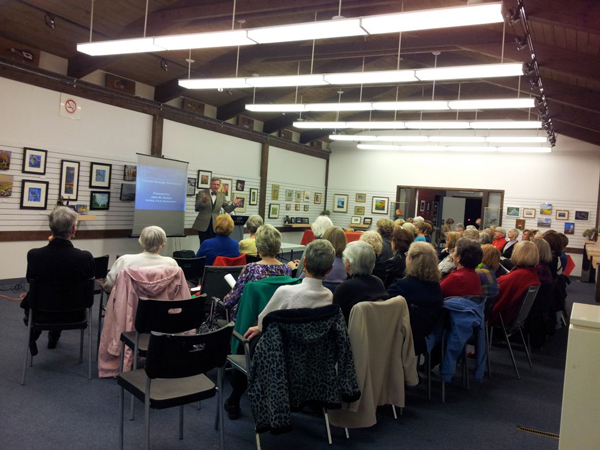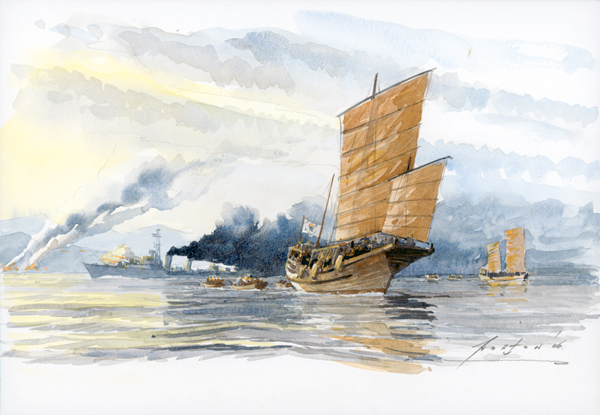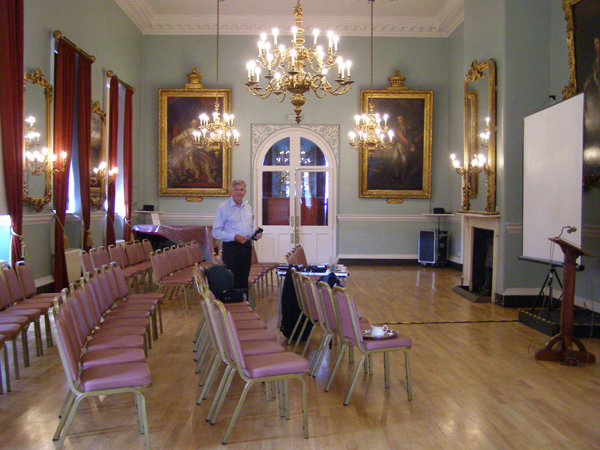Do you belong to an adult or student group that invites speakers to make presentations? Would your group be interested in a dynamic speaker with an artistic marine focus? If so, read the following information about talks John presents throughout the year. All of John’s power point presentations include many images of his or other marine artist’s paintings.

Explore the West Coast of North America with Captain George Vancouver
Find out why he named it Desolation Sound Learn the inside stories about Vancouver’s exploration of the coast, including the discovery and protection of a Shaman’s burial cave; his friendship with England’s enemy, the Spanish, and a really important story about why Hawaii is not English. Vancouver’s extended survey of the northwest coast was an astonishing achievement. His voyage proved to be the longest continuous journey of discovery under sail, in history, both in time and in distance covered. Neither Cook nor Columbus, nor any other explorer, has proven to equal this accomplishment. And yet, his life ended at 40, in poverty and with no recognition. Why? This presentation has full screen colourful paintings of our coast – showing places Captain Vancouver charted and named and 25 of John’s over 50 paintings about Captain Vancouver’s exploration of the coast, from California to Alaska. John travelled to Alaska in 2011, for the 4th time, to research more stories about this voyage. In 2012 John presented this talk 11 times to yacht clubs, a newcomers group, power squadrons, school groups and a Rotary Club. After the last talk John just happened to be walking behind the 2 organizers and overheard “Wow, how are we going to follow that talk?”

Canadian Art and War
Find out what these two subjects have in common with this powerful presentation by John M. Horton, one of Canada’s Naval War Artists. John Horton was the first artist appointed to the reinstated Canadian War Art programme, renamed the Canadian Forces Artist’s Programme (CFAP) in 2002 and was sent to join our Navy in the Arabian Gulf aboard HMCS Algonquin. Since John had been in the Royal Navy in the Atlantic, Arctic and Pacific Oceans and in the Canadian Navy Reserve this exposure to the action and activities in the Arabian Gulf gave him the updated knowledge to record our Navy as it is now. This is so different from when he started as a boy seaman in 1951. Joining Operation Apollo in the Arabian Gulf gave him the opportunity to create paintings that recorded the Canadian Navy’s role in the “War on terrorism”. Since his Operation Apollo trip John has been at sea aboard more of Canada’s ships – a notable deployment was his 5 week “RIMPAC” trip when he visited ships of 4 of the 8 navies involved in this multinational pacific rim exercise. He has also joined HMCS Windsor in his first submarine voyage and HMCS Vancouver for a special journey from Vancouver WA to Vancouver BC to commemorate the 200th anniversary of Captain Vancouver’s birth. . So many of the associations of which John is a member wanted to hear about John’s trip to the Arabian Gulf, that he prepare a power point presentation. Researching this talk encouraged John to include information about the beginning of Canada’s war art programmes started by Lord Beaverbrook in 1916. He was also interested in the other war artists and the successive programmes that Canada produced to capture the horror and history of war. The War Museum in Ottawa has supplied pictures for this presentation and you will find it not only informative, but also quite enlightening as to why an artist would go to war and subject themselves to the dangers and depravations. The talk by John highlights the history of Canada’s various war art programmes from the First and Second World Wars to the present day. We think you will be interested to know that the Canadian Encyclopedia states that Canada was the first country to produce such a programme. Using images of many other war artists, John’s presentation highlights and promotes the many successes of our fleet and the men and women who have served over the last 100 years. It also gives you a brief history of the Canadian Navy through 15 watercolour sketches that he produced as his application for the 2010 centennial art programme.

A look at the marine art of John M. Horton
John M. Horton, internationally acclaimed marine artist, talks about his work and shows images of his paintings in this lavishly illustrated power point presentation. Through photographs of a painting in progress he illustrates how he produces his very detailed, technically accurate paintings of contemporary ships and historical vessels, and the exciting landscape and historical buildings that form backgrounds. If you love marine art this is the presentation for you. Techniques developed over years of producing architectural renderings and designs for world-wide clients are incorporated in these stunning paintings. Many clients say they can tell a Horton painting simply by looking at the clouds and the mood of the water. This knowledge has been gained by a lifelong love of and journeys on the sea. As a child he carried a sailboat under his arm – not a teddy bear. How did this artist become an artist? Find out about an accident at 4years of age that changed his life. Hear fun stories about his training, apprenticeship, where he trained, his mentors, his inspiration and muses.
These presentations have always been well received by extremely varied audiences – we invite you to contact Mary at 604 943-4399 or mary@johnhorton.ca to discuss a time/date for this talk
